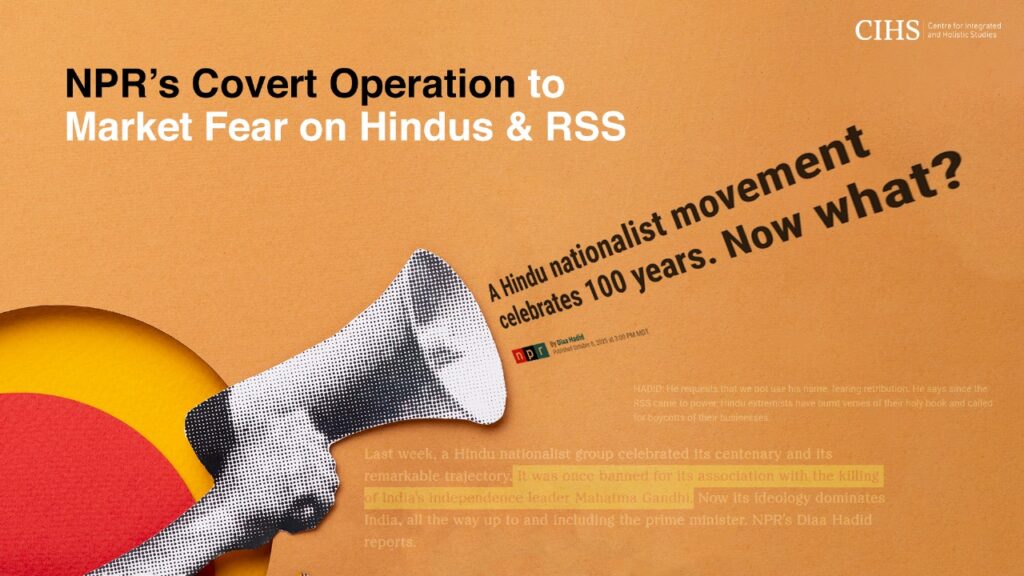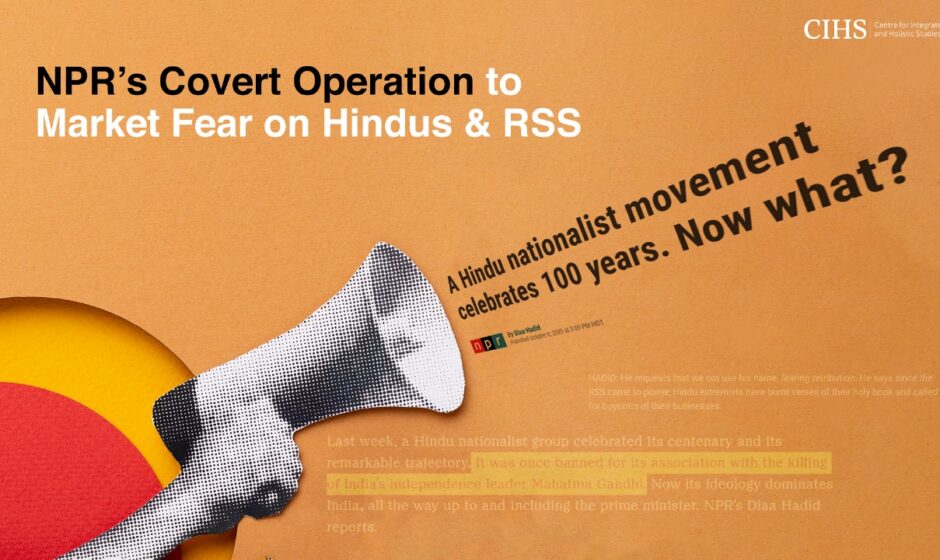Dr Aniket Pingley / Nagpur
Were someone to write a handbook on “Pandering to Prejudice while Pretending to Report,” they need look no further than Diaa Hadid’s National Public Radio (NPR) write-up and radio broadcast RSS. Hadid hides lack of diligence behind familiar imagery and attempts to flatter an audience expectation instead of testing them.

Hollywood often turns social problems into entertainment. Crime, addiction and family breakdown appear again and again in films. These stories do not describe society as it is; they present a pattern that audiences already know. By recycling them, filmmakers sell a sense of realism itself. Sociologists have called this commodification of stereotypes where social anxieties are turned into products that people can consume.
Hadid’s radio report for NPR titled “A Hindu nationalist movement celebrates 100 years. Now what?” follows the very pattern? The report attempts to present Bharat through a ready-made frame of danger and division. The listeners / readers are not invited to learn something new; they are prodded to recognize something familiar, a martial or fascist Hindu organisation, fearful Muslims and a society leaning toward intolerance.
This works well for Western audience who have been mentally “incepted” for years by shoddy journalism to consume such stories as both alarm and entertainment. It becomes a reaffirmation that their liberal conscience remains intact.
I have lived in the USA for more than a decade. I have listened to NPR on radio for years during my daily commute. Over time, I came to notice a pattern in its coverage of India. Their tone is rarely one of inquiry or balance; it is one of quiet moral certainty.
Their general method is not to argue openly but to evoke unease through association, mood and selective recall. It is in this sense that Diaa Hadid’s report on the centenary of RSS fits perfectly within NPR’s broader narrative framework.
I will expose anatomy of NPR’s covert style of building narrative. To this end, I will first explain the covert devices used by Hadid.
Covert Devices
Hadid’s piece works through three main covert devices: visual cues, selective use of authority and affective storytelling.
a. Visual cues
The report opens with the image of “more than 1,000 men in khaki pants, white shirts, black hats marched in step, bamboo canes at the ready.” This picture establishes the mood before any facts are given. The imagery evokes paramilitary spectacle; audience’s imagination supplies menace before any argument begins. It does not explain what the event represents; it signals threat. Once this image is fixed, every later detail reinforces it.
b. Selective authority
Hadid then attempts to construct credibility through Sangh baiters like Nilanjan Mukhopadhyay and Saba Naqvi. Their observations are not contextualised; the audience is not told that these voices represent one interpretive tradition among many. Their audio bytes are cherry-picked to deliver a uniform message: Hindu nationalism feeds resentment, controls institutions and endangers pluralism. This is nothing more than an echo-chamber.
c. Affective storytelling
A later section features an unnamed Muslim activist who “fears retribution.” No evidence or data is offered to support how widespread this fear is. The emotion itself is projected as the proof. The audience does not have to ask for data or context; feeling replaces verification. In short, where evidence should appear, emotion takes its place.
Symbols and Stigma
Reference to the film, The Kerala Story, is most telling rhetorical move. The film bears no institutional connection to RSS and belongs to the domain of popular cinema. Its presence in the report functions as symbolic contagion, i.e., by mentioning the movie immediately after discussing RSS “influence on Bollywood,”
Hadid fuses disparate cultural artefacts into a single moral field. The RSS thus becomes responsible not only for political developments but also for cinematic representations of Muslims. For a Western audience already primed to associate “Hindu nationalism” with intolerance, such conflation produces instant engagement.
To amplify stigma about RSS, Hadid retrieves the prevalent elements of Western archive on the RSS – (1) Mahatma Gandhi’s assassination and (2) Ram Janmabhoomi movement. There is no acknowledgment that RSS was exonerated after Gandhi’s death or that it operates legally within India’s constitutional framework, or that Ram temple was built via Supreme Court judgment after a long, patient waiting by the entire nation.
Hadid repeats familiar falsehood that “Godse was once a follower of the RSS. Godse’s family insists he never left,” ignoring Godse’s own courtroom statement that he had left the RSS to join the Hindu Mahasabha. But then, fact-checking has never been a priority for those committed to manufacturing history and Hadid is neither the first nor the last to do so.
Here, each reference functions to deliberately misguide or act as a cue that re-connects today’s audience to an existing moral verdict.
The long and the short of it
The anatomy of NPR’s false narrative building has the following parts:
- Stabilizing a stereotype by projecting RSS as perennial threat through repetition of inherited imagery.
- Delegating accusation to chosen commentators, preserving the journalist’s formal neutrality while ensuring the desired interpretation.
- Embedding of affective evidence, i.e., unnamed fear, cinematic analogy etc., so that emotional conviction replaces empirical verification.
Exposing the institutional motive of NPR
Hadid’s report exemplifies an institutional pattern within Western public media: to convert complex national phenomena into moral parables for liberal consumption. RSS becomes a semiotic device, a shorthand for all that is wrong with contemporary India. In this symbolic economy, factual depth is secondary to recognizability.
Diaa Hadid’s NPR piece about RSS centenary does not break new ground. It follows Hollywood model of selling familiar anxieties. This is not an individual failure of journalism but a sign of how certain institutions continue to operate. They produce stories that confirm a shared moral outlook rather than test it.
The result is not better understanding of Bharat or RSS, but another example of how complex realities can be reduced to simple and marketable fears.
P.S. As for “Now what?” from the title — perhaps, now, some real journalism 😊
(Author is an accomplished computer scientist, educator, and holds expertise in media content strategy)


